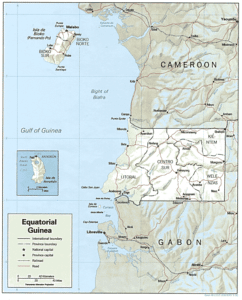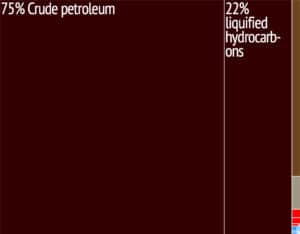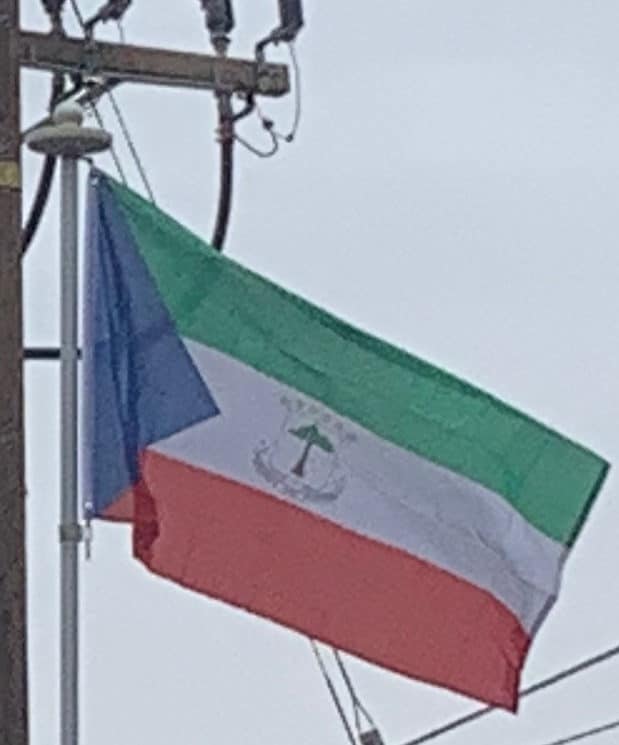In 2011, the government announced it was planning a new capital for the country, named Oyala. The city was renamed Ciudad de la Paz (“City of Peace”) in 2017.
As of February 2016, Obiang is Africa’s second-longest serving dictator after Cameroon’s Paul Biya.
Geography:
Equatorial Guinea is on the west coast of Central Africa. The country consists of a mainland territory, Río Muni, which is bordered by Cameroon to the north and Gabon to the east and south, and five small islands, Bioko, Corisco, Annobón, Elobey Chico (Small Elobey), and Elobey Grande (Great Elobey). Bioko, the site of the capital, Malabo, lies about 40 kilometers (25 mi) off the coast of Cameroon. Annobón Island is about 350 kilometers (220 mi) west-south-west of Cape Lopez in Gabon. Corisco and the two Elobey islands are in Corisco Bay, on the border of Río Muni and Gabon.

Despite its name, no part of the country’s territory lies on the equator—it is in the northern hemisphere, except for the insular Annobón Province, which is about 155 km (96 mi) south of the equator.
Economy:
Before independence Equatorial Guinea exported cocoa, coffee and timber, mostly to its colonial ruler, Spain, but also to Germany and the UK. On 1 January 1985, the country became the first non-Francophone African member of the franc zone, adopting the CFA franc as its currency. The national currency, the ekwele, had previously been linked to the Spanish peseta.
The discovery of large oil reserves in 1996 and its subsequent exploitation contributed to a dramatic increase in government revenue. As of 2004, Equatorial Guinea is the third-largest oil producer in Sub-Saharan Africa. Its oil production has risen to 360,000 barrels per day (57,000 m3/d), up from 220,000 only two years earlier.
Forestry, farming, and fishing are also major components of GDP. Subsistence farming predominates. The deterioration of the rural economy under successive brutal regimes has diminished any potential for agriculture-led growth.

In July 2004, the United States Senate published an investigation into Riggs Bank, a Washington-based bank into which most of Equatorial Guinea’s oil revenues were paid until recently, and which also banked for Chile’s Augusto Pinochet. The Senate report showed at least $35 million siphoned off by Obiang, his family and regime senior officials. The president has denied any wrongdoing. Riggs Bank in February 2005 paid $9 million in restitution for Pinochet’s banking, no restitution was made with regard to Equatorial Guinea.
From 2000 to 2010, Equatorial Guinea had the highest average annual increase in GDP (Gross Domestic Product), 17%.
Equatorial Guinea is a member of the Organization for the Harmonization of Business Law in Africa (OHADA). Equatorial Guinea tried to be validated as an Extractive Industries Transparency Initiative (EITI)–compliant country, working toward transparency in reporting of oil revenues and prudent use of natural resource wealth. The country obtained candidate status on 22 February 2008. It was then required to meet a number of obligations to do so, including committing to working with civil society and companies on EITI implementation, appointing a senior individual to lead on EITI implementation, and publishing a fully costed Work Plan with measurable targets, a timetable for implementation and an assessment of capacity constraints. However, when Equatorial Guinea applied to extend the deadline for completing EITI validation, the EITI Board did not agree to the extension.
